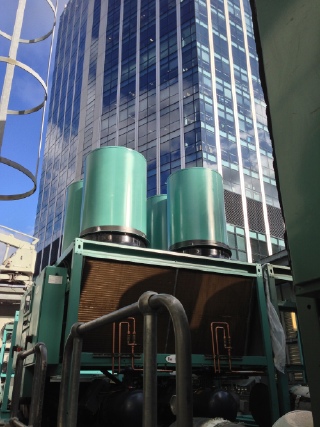The final countdown for R22
There is still lots of equipment out there using R22 which will become unserviceable at the end of this year. Trevor Dann of ThermOzone traces the journey to this point and the options over the next few months.
Before 1987 we were warned we would all be wiped out by radiation from the hole in the ozone layer that we had apparently created by use of CFCs. The hole has since reduced in size, but no one really knows if this is a natural phenomenon. Whatever may be said, it has provided the political classes with a case that they claim has been a winner for them. Meanwhile the effects of fossil fuel use continue to increase, and our islands will instead be smothered with windmills!
The final implementation of the 1987 Montreal Protocol for worldwide phase down of gases affecting the atmospheric ozone layer is the phase-out of HCFCs, following the earlier phase-out of CFCs in 1997. This will happen on 31st December this year. After this time ‘service’ use of HCFC compounds, notably R22, will be illegal.
Systems using R22 or its many derivative blends as their operating fluid may continue to operate after this time, but will effectively be non-serviceable. Any leak or any maintenance requiring removal of the refrigerant will require an alternative refrigerant. To re-charge any system with any R22 compound will be illegal, and those culpable shall be breaking criminal law.
There is a wide range of alternative ‘direct-replacement’ refrigerants available, colloquially known as ‘drop ins’. The issue is that generally they are anything but ‘drop ins’.
“… Why, oh why, must I do this, and how long have I known I must act …” is the cry that we so often hear.
Well the calendar for phase out was set down before 1995, so at least 20 years! New equipment using R22 was mostly banned in new manufacture by 2000, save for a few heat-pump applications, so the vast majority of equipment still using R22 is at least 15 years old.
Herein lies the rub; equipment that is 15 years old or more and seemingly refused proper attention by the bean counters will not only become unserviceable as far as the refrigerant is concerned, but the invasive work and massive variation in individual circumstances means each specific incidence will present a differing set of variables to be dealt with.
• Age related defects.
• Incompatibility with the selected refrigerant.
• Worn out critical components.
• Unknown service history of equipment.
• etc.
Those firms active during the first phase of refrigerant phase outs — the notorious CFCs R11, R12 and R502, will recall that the users of those gases were given barely a few years to act, and a very steep learning curve was climbed. R22 users were given a far longer stay of execution, yet apparently with just a few months to go it is generally reckoned that possibly 50% of buildings using air-conditioning equipment still have R22 in use.

So what are the options?
1 Continue to do nothing and hope. Expecting any reputable service firm to condone ongoing and, by then, illegal service support for this older equipment is simply unrealistic and unfair.
2 Gas retrofit. Techniques are well established, but implementation can become very costly. For those holding financial obligations to make such undertakings, a clear understanding of contractual and legal obligations is essential. For those taking on the actual task of implementing gas retrofit, ensuring their contractual position is protected is certainly wise. Gas retrofit is by no means a panacea to getting rid of R22!
3 New equipment. This will generally be the most costly option and for larger plant equipment can cause major upheaval and secondary costs — building works, crane costs, road closures, replacement of associated plant equipment.
4 Whole-plant retrofit. R22 retrofit presents a massive opportunity to make other significant environmental gains, particularly energy savings. It is feasible to not only remove R22 successfully, but also to assign lower-cost refrigerants (non-direct replacements) that offer considerable improvements in energy efficiency, e.g. R134a or R407C, alongside other recent techniques established for larger air-conditioning plant. Inverter-driven screw compressors can offer energy savings of over 70% compared to the equivalent reciprocating (piston) compressor. Applying R134a can extend specific savings to 80%, with average savings greater than 50%. Modern electronically commutated (EC) fans reduce fan energy by 30%. Upgrading plant also allows other age-related defects to be attended to.
Next, a word of warning about the review of the F Gas Directive —phase out is not finished with yet!
The recent review of the F Gas Directive by the EU requires elimination of most refrigerants having a Global Warming Potential (GWP) above 150 by 2030. This sets down a reduction of 80% the average quantity in use during the period 2008 to 2011 in four step stages by 2030. This means all HFCs — anything using R134a, including all R400 series blended refrigerants (R404A, R407C and R410A) and all direct-replacement blends).
Making this situation even more dire is that medical uses of HFCs account for 6% of the current (2008 to 2011) quantity; this is excluded from the phase down requirement but is counted in the total, so by 2030 the rest of HFC usage will have to reduce further to compensate — which works out as a reduction in real terms of 86%.
The replacements now under development are termed HFOs. Hydrocarbons (HCs) are already partially established in small (domestic) equipment. These refrigerant groups have the significant disadvantage over HFCs and the H/CFCs they replaced, of being flammable — some very flammable. The energy effectiveness of these gases remains to be proven.
Have you acted yet? Do you know what R22 remains in your buildings? Do you have an action plan to move beyond R22? It is time to start thinking about moving beyond HFCs.
Trevor Dann is technical and sales director with ThermOzone.







